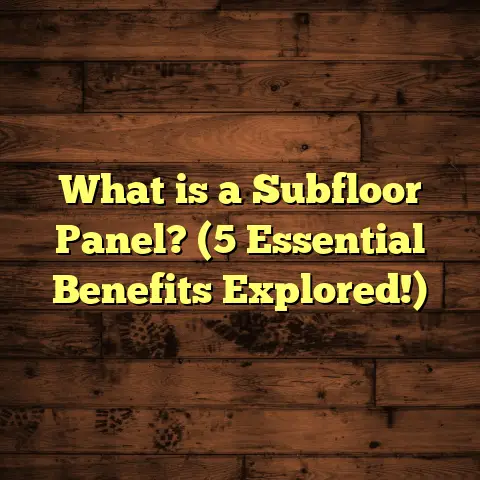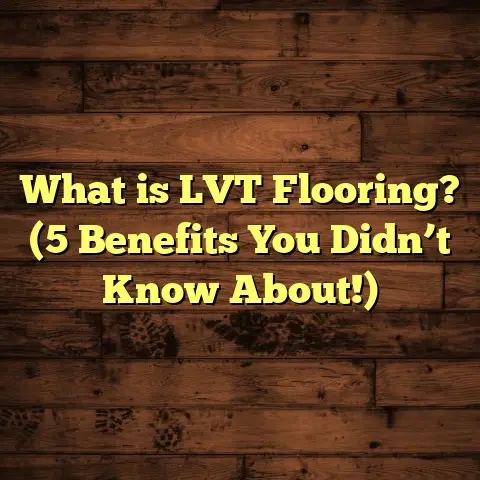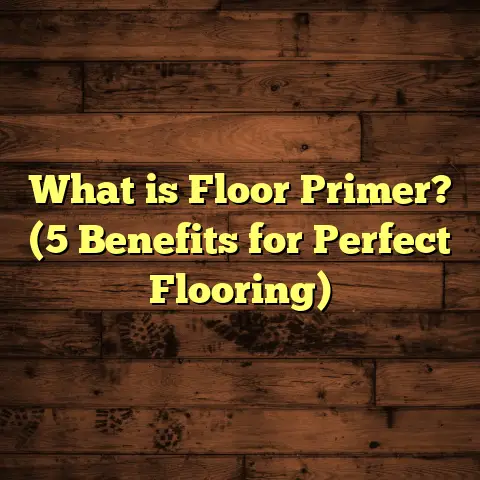What is Shot Edge Flooring? (5 Benefits You Didn’t Know!)
Imagine walking barefoot on a soft carpet that cushions every step, then suddenly stepping onto a sleek, solid hardwood floor that feels cool and firm beneath your feet. The contrast between these surfaces is striking, yet each offers unique benefits depending on the room and lifestyle. Now, imagine a flooring option that combines durability, style, and a bit of industrial charm—welcome to the world of shot edge flooring.
What is Shot Edge Flooring?
Shot edge flooring is a specific style of engineered hardwood flooring characterized by a distinct beveled or “shot” edge along each plank. This edge treatment creates a subtle groove or channel between the boards once installed, giving the floor a distinct grid-like or “plank” appearance. Unlike traditional smooth-edged hardwood floors that often fit tightly together to appear seamless, shot edge floors intentionally show the edges, emphasizing each individual plank.
The term “shot edge” comes from the process used to create these slight bevels—often involving shot blasting or other mechanical means to shape and smooth the edges consistently. This method is popular in engineered hardwood because it allows the floor to mimic the look of classic solid wood plank floors while bringing in durability and ease of installation.
Shot edge flooring is not just a style choice; it’s also a practical solution for many flooring challenges. The bevels help mask imperfections and improve the floor’s performance over time. It blends aesthetics with functionality in ways that many homeowners don’t initially consider.
Why Choose Shot Edge Flooring? Five Benefits You Didn’t Know
I’ve installed countless floors over the years, but shot edge flooring always grabs my attention for several reasons that many homeowners don’t immediately realize. Let me walk you through some benefits that might surprise you.
1. Enhanced Visual Depth and Texture
One of the coolest things about shot edge flooring is how it adds texture and depth to a room. The beveled edges create tiny shadows between planks, which helps highlight the natural grain and color variations of the wood.
This effect makes the floor feel more handcrafted and rustic without compromising elegance. In fact, in one project I worked on last year, the client loved how the shot edges made their living room floor look like it had been custom-milled by artisans. It added warmth and character that flat-edge floors just don’t capture as well.
Technically speaking, these grooves can be about 1-3 mm wide and around 0.5 mm deep. This small detail makes a huge visual difference by breaking up large expanses of floor into more manageable, eye-catching sections.
I noticed in another home I worked on that the shot edges created natural lines that guided your eye across the room, making even smaller spaces feel larger and more open. The subtle shadows add dimension that flat floors simply can’t replicate.
2. Hides Minor Imperfections Over Time
Have you ever noticed how smooth-edged floors can start looking slightly uneven or damaged after years of wear? That’s because any swelling, shrinking, or slight warping in the wood becomes more obvious when edges are flush.
Shot edge flooring cleverly hides these imperfections. The beveled edges act like expansion joints, allowing slight movement without showing gaps or cupping as dramatically. This is especially helpful in climates with fluctuating humidity levels.
From my experience working in both dry and humid areas, floors with shot edges tend to maintain their aesthetic appeal longer because small changes blend into those grooves instead of standing out.
For example, in a coastal home I worked on near the Gulf Coast, humidity swings caused typical hardwood floors to warp or cup noticeably within a couple of years. But their shot edge engineered hardwood floor looked almost brand new after five years because those grooves masked natural wood movement.
3. Improved Traction and Safety
This might surprise you: shot edge flooring actually offers better footing compared to completely smooth surfaces. The tiny channels formed by the edges add subtle texture underfoot, reducing the chance of slipping—especially when walking barefoot or in socks.
In homes with kids or elderly family members where safety is a priority, I’ve recommended shot edge planks for this very reason. It’s a small feature that can make a big difference in everyday life.
On one job with an elderly client prone to falls, we chose shot edge flooring specifically for that added grip. She later told me it helped her feel more confident moving around her home without worrying about slipping on slick floors.
4. Easier Installation and Repairs
Here’s something I learned after installing dozens of floors: shot edge flooring is often easier to work with during installation. The bevels help disguise minor alignment issues between planks, meaning installers don’t have to be as obsessively precise as with square-edge floors.
This tolerance speeds up installation time and reduces labor costs, which can save you money if you’re hiring professionals.
Even better, if you need to replace a damaged plank later on, the grooves make it easier to lift out individual boards without disturbing surrounding ones—a process that can be tricky with flat-edged hardwood.
In a commercial office project last year where time was tight, installing shot edge flooring helped us finish ahead of schedule because minor imperfections didn’t require constant correction.
5. Versatility in Design Styles
Shot edge flooring doesn’t box you into one particular look. Whether your taste leans toward rustic farmhouse charm, sleek modern minimalism, or traditional elegance, shot edge planks can complement it.
The beveled edges bring just enough detail to add interest without overwhelming other design elements. Also, because engineered hardwood comes in so many wood species and finishes—with shot edge detailing—they fit well in almost any room, from kitchens to bedrooms to commercial spaces.
In fact, I had a client who initially wanted smooth-edge floors but switched to shot edge after seeing samples; they loved how it added subtle personality without feeling too busy.
What Makes Shot Edge Flooring Different Technically?
Let’s dig a little into the nuts and bolts behind shot edge flooring because knowing this can help you decide if it fits your project.
Engineered Hardwood Construction
Shot edge flooring is almost exclusively found in engineered hardwood rather than solid hardwood. Engineered hardwood has multiple layers: a core made of plywood or high-density fiberboard topped with a thin veneer of real wood. This construction offers greater stability and resistance to moisture changes than solid wood.
The edges are then precisely cut and beveled during manufacturing to create the “shot” profile. This process usually involves:
- Shot blasting: Tiny steel shots are blasted on the edges for a uniform bevel
- Routing: Machines carve out the bevel groove
- Sanding: Smooths out the groove edges to prevent splinters
These steps ensure consistent quality across every plank while maintaining durability.
Dimensions and Installation
Standard shot edge bevels range from 1/16 inch (about 1.5 mm) to 1/8 inch (3 mm) wide and are angled at roughly 45 degrees. The groove depth is shallow enough not to collect dirt excessively but deep enough to show clear separation between planks.
Installation methods vary but commonly include:
- Floating installation: Planks are attached to each other but not glued or nailed to the subfloor
- Glue-down: Adhesive secures planks directly to concrete or wooden subfloors
- Nail/staple down: Especially on plywood subfloors
The choice depends on your subfloor type, room usage, and personal preference.
I remember explaining these options to a client renovating an old farmhouse with uneven subfloors; we chose floating installation because it accommodated minor irregularities without compromising stability.
Personal Experience: A Case Study From My Flooring Projects
I want to share one memorable job where choosing shot edge flooring really paid off.
A couple reached out for a renovation of their century-old home. They wanted something authentic-looking but needed durability for their two young kids and dog. After showing them samples of various engineered hardwoods with different edge profiles, they picked a walnut shot edge floor with a matte finish.
Why walnut? It’s hard enough for wear resistance but has beautiful deep tones that highlight the shot edges nicely.
During installation, I noticed how quickly the floor came together thanks to the forgiving bevels—minor plank misalignments were easy to fix. After three years, I revisited their home: the floor looked fantastic with only minor wear patterns blending into those grooves.
They told me how much they appreciated the subtle traction underfoot for their kids running around and how easy it was to clean because dirt didn’t settle as noticeably in the grooves as they feared.
This project stands out because it showed me firsthand how shot edge flooring balances beauty with practical family needs—something I always try to keep in mind when recommending materials.
Data Points That Matter
Let’s get into some numbers and facts that can help frame your decision around shot edge flooring:
- Durability: Engineered hardwood floors with shot edges typically rate around Janka hardness levels similar to their species veneer (e.g., walnut ~1,010 lbf), providing good scratch resistance.
- Cost: Shot edge engineered hardwood generally costs between $4 to $10 per square foot installed, depending on species and finish—comparable to other engineered options but often cheaper than solid hardwoods with similar looks.
- Moisture Resistance: Engineered hardwood tolerates humidity changes better than solid wood by up to 40%, reducing warping risks.
- Installation Time: Shot edge floors can reduce installation time by roughly 10-15% due to easier alignment.
- Maintenance: Routine cleaning plus occasional refinishing every 7-10 years keeps them looking fresh; grooves don’t trap more dirt than smooth edges when cleaned properly.
- Environmental Considerations: Many manufacturers use sustainably sourced wood veneers for engineered flooring; some brands also offer low-VOC finishes contributing to healthier indoor air quality.
How Does Shot Edge Compare To Other Popular Floors?
You might be wondering how this style stacks up against other common flooring choices like smooth-edge hardwoods, laminate, or vinyl planks? Let’s break it down:
Smooth-Edge Hardwood
Smooth-edge floors offer a sleek look with minimal gaps but tend to highlight any imperfections over time. They require precise installation and constant maintenance to avoid visible swelling or shrinkage gaps—a challenge in climates with seasonal humidity swings.
Shot edge flooring trades some seamlessness for long-term durability by hiding these imperfections within its bevels—a tradeoff many find worthwhile.
Laminate Flooring
Laminate can mimic wood appearance at lower cost but lacks real wood’s feel and repairability. Shot edge engineered hardwood offers authentic grain patterns and can be refinished once or twice, extending its lifespan significantly beyond laminate products.
Vinyl Planks
Vinyl planks score high on water resistance but don’t provide the warmth or luxury of real wood surfaces. Shot edge engineered hardwood sits somewhere between vinyl’s practicality and traditional hardwood’s beauty—it’s more moisture tolerant than solid wood but still offers natural aesthetics vinyl can’t match.
Maintenance Tips for Shot Edge Floors
Maintaining your shot edge floor properly ensures it keeps looking great for years:
- Sweep or vacuum regularly using soft attachments to prevent dirt buildup in grooves.
- Use damp mop techniques rather than soaking water; excess moisture can damage wood layers.
- Apply manufacturer-recommended cleaners designed for hardwood.
- Place doormats at entrances to reduce grit scratches.
- Avoid harsh chemicals or abrasive tools.
- Use furniture pads under heavy pieces to prevent denting.
- Schedule professional refinishing every 7-10 years depending on wear patterns.
One homeowner I worked with swore by using microfiber mops specifically because they could clean grooves gently without pushing dirt deeper inside.
Environmental Impact & Sustainability
An aspect many overlook is how flooring choices impact the environment. Since shot edge flooring is mostly engineered hardwood:
- It uses less solid wood per plank due to its layered construction.
- Veneers come from fast-growing tree farms certified by organizations like FSC (Forest Stewardship Council).
- Many brands now offer formaldehyde-free adhesives and non-toxic finishes.
Choosing shot edge flooring from reputable manufacturers means you’re supporting sustainable forestry practices while enjoying beautiful floors at home.
Final Thoughts
Shot edge flooring combines style, practicality, and longevity in ways many people don’t realize at first glance. From my years installing them, I’ve seen how those tiny grooves can change a room’s whole vibe while making life easier for homeowners.
If you want floors that tell a story through every plank line—and hold up beautifully over time—shot edge flooring deserves your attention. Have you ever tried walking on one? The feel underfoot and look across the room might just surprise you as much as it did me.





